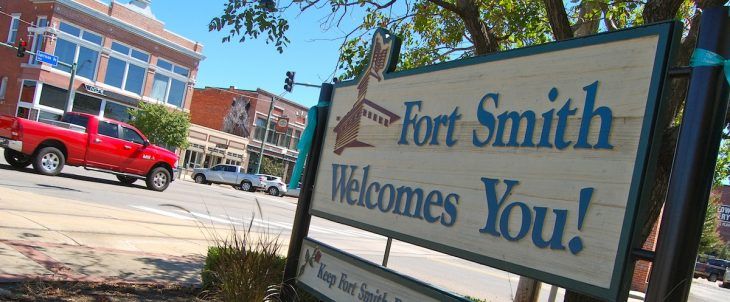Downtown Fort Smith plan gets truck traffic setback
by October 26, 2017 9:01 pm 1,131 views

Efforts to reduce truck traffic on Garrison Avenue in downtown Fort Smith as part of the Propelling Downtown Forward strategic plan took a step back recently after the Arkansas Department of Transportation (ArDOT) weighed in on whether cities have the power to restrict travel on state and federal highways.
Fort Smith Deputy City Administrator Jeff Dingman sent an email to John Settle, the city’s prosecuting attorney, on June 29 inquiring about the validity of City Ordinance 24-72, which states that when a truck bypass is properly designated and the route is “clearly and definitely marked with proper signs, it shall be a misdemeanor for all trucks required to use such truck by-passes to travel on any other portions of the city streets, except that trucks may turn off the designated route for the purpose of making deliveries of merchandise or to pick up merchandise.”
The ordinance continued: “The trucks operating under this exception must proceed as near their destination as possible before turning off the by-pass and return to the same by the nearest direct route.”
Settle responded that the State Highway Commission, pursuant to Arkansas Code Annotated (ACA) 27-67-202, “is authorized to ‘designate and establish truck routes through cities and towns.’ … According to the State Highway Commission website, they have designated Garrison Avenue, Rogers Avenue, and Towson Avenue as ‘truck routes,’ ‘no trucks’ allowed. The statute and the State Highway Commission map are very clear on this issue.”
But Russ Bragg of OK Foods reached out to Chad Adams, district four engineer with ArDOT, stating that, going forward, “it will be essential for any of the plans to work to have great involvement from the Arkansas Highway Transportation Department (ArDOT prior to rebranding).”
Bragg referred Adams to the map that Settle had shared, stating it was “apparently on the I Drive Arkansas website” and that “I have not been able to find any language that authorized or supports the red lines on the map. Certainly there has to be some. It also seems strange that such a broad swath was carved out as it would theoretically inhibit so much commerce.”
Bragg continued: “If your team can tell me when these designations occurred and where the language is that makes the specific recommendations or rules, that would be a great help to us.”
Adams responded to Bragg on July 5 stating that he was still looking into the legality of restrictions. In a more recent email, he wrote that ArDOT had “researched the issue at hand and have determined the following: The City’s Ordinance establishing a Truck Route does not legally restrict trucks from using State Highways. AHTD (soon to be ARDOT) does have the authority to set restrictions on US and State Highways. However, we only do so when there is proper justification for such a restriction. At this time, there is no known justification for restricting truck traffic on US and State Highways through Fort Smith. As such, the ‘No Trucks’ designation previously shown on iDrive has been removed.”
The decision places the city back at square one for dealing with truck traffic through downtown Fort Smith, but options do remain. For starters, the city could slow down traffic on Garrison through control of the speed and synchronization of traffic lights.
However, Dingman noted, “that would have to be something the street department does, but we do have to go through them (ArDOT) and say, ‘This is what we want to do,’ and show the reasonableness of it, and the highway department would have to sign off on it.”
For now, the city plans to proceed with a traffic count and get third-party engineer support to see what actions are justifiable.
